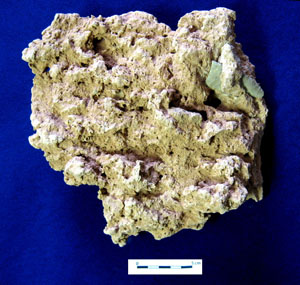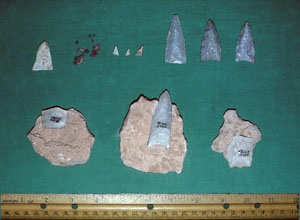Sub-Stratum 8B: “Plainview 2”
Separated from Sub-Stratum 8A by 6 to 8 inches of red sand, this sub-stratum is covered by a cemented sand cap about ½- to 1-inch thick. The cemented layer is of varying thickness and is not completely solid. Almost all of the occupational debris was found adhering to this matrix, including dart points. Thus, the casts of several points were obtained.
Four complete lanceolate projectile points were found in this stratum, as well as fragments of others. These were first identified as Plainview, based on the original type definition. However, as archeologist Michael Collins and others have pointed out, classic Plainview points from the type site are generally thinner and have a different flaking technology from these; moreover, Plainview are considerably older. Additional studies may correlate the Horn Shelter lanceolate points to Late Paleoindian types Dalton or the similar forms, St. Mary's Hall and Golindrina-Barber.
Two of the points have been resharpened creating a slight bevel on the edges. One of the points was broken prehistorically into five fragments, only three of which were found. Fragments of at least three additional points were recovered, but these could not be refitted to any specimen. In all, nine projectile points were represented in this layer. Some 80 small flint chips of the same type of material as the tip were scattered nearby. Other cultural materials include a well-used flint hammerstone, red ocher fragments, and utilized flakes.
A sample of snail shells provided a radiocarbon age of 8400 B.P. +/- 110 years (9250 to 9490 calibrated years B.P.) for this stratum.

|
